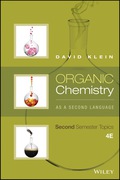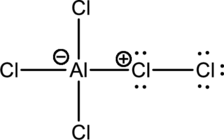
EBK ORGANIC CHEMISTRY AS A SECOND LANGU
4th Edition
ISBN: 9781119234722
Author: Klein
Publisher: JOHN WILEY+SONS,INC.-CONSIGNMENT
expand_more
expand_more
format_list_bulleted
Question
Chapter 4.1, Problem 4.3P
Interpretation Introduction
Interpretation:
Mechanism for the electrophilic substitution reaction of benzene with the below complex has to be drawn.

Expert Solution & Answer
Want to see the full answer?
Check out a sample textbook solution
Students have asked these similar questions
8. a) Propose a mechanism for the following electrophilic aromatic substitution reaction
used to make the synthetic dye shown below. This reaction is also called a "diazo
coupling".
butter yellow
(synthetic dye)
b) Explain why the para pathway would be favored over the meta pathway. Be sure to
draw all resonance structures for the para pathway and include a sentence or two for a full
explanation. Why would the para pathway be favored over the ortho pathway?
just answer #1, 2, and 3 and answer briefly. no more explanation needed.
For each reaction, decide whether the reaction is a
redox reaction, acid-base reaction, electrophile-
nucleophile, or something else. One can begin to
identify the type of reaction by looking to see if
oxidation numbers of atoms that take part in the
reaction change during the reaction. You will need
to draw out the structures.
a. If the reaction is considered an acid-
base reaction, draw out the full
mechanism for the reaction. Be sure to
indicate which compound is the acid,
base, and conjugate acid and base
(where possible).
b. If the reaction is considered a redox
reaction, be sure to indicate which
species are oxidized and which are
reduced.
c. For every reaction you will need to
justify your identification of the type of
reaction.
Chapter 4 Solutions
EBK ORGANIC CHEMISTRY AS A SECOND LANGU
Ch. 4.1 - Consider the following reaction, in which an...Ch. 4.1 - Prob. 4.3PCh. 4.1 - Aromatic rings will also undergo iodination when...Ch. 4.2 - In each of the following cases, identify the...Ch. 4.2 - In each of the following cases, identify the...Ch. 4.2 - In each of the following cases, identify the...Ch. 4.3 - Prob. 4.10PCh. 4.3 - Prob. 4.11PCh. 4.3 - Prob. 4.12PCh. 4.3 - Prob. 4.13P
Ch. 4.3 - Prob. 4.14PCh. 4.3 - Predict the products of the following reaction.Ch. 4.3 - Prob. 4.16PCh. 4.3 - Prob. 4.17PCh. 4.4 - Identify the reagents you would use to achieve...Ch. 4.4 - Identify the reagents you would use to achieve...Ch. 4.4 - Identify the reagents you would use to achieve...Ch. 4.4 - Identify the reagents you would use to achieve...Ch. 4.4 - fill in the reagents you would use for the...Ch. 4.4 - fill in the reagents you would use for the...Ch. 4.4 - fill in the reagents you would use for the...Ch. 4.4 - fill in the reagents you would use for the...Ch. 4.4 - Prob. 4.27PCh. 4.4 - Prob. 4.28PCh. 4.4 - And now, for a challenging problem, try to draw...Ch. 4.6 - Prob. 4.31PCh. 4.6 - Prob. 4.32PCh. 4.6 - Prob. 4.33PCh. 4.6 - Prob. 4.34PCh. 4.6 - Prob. 4.35PCh. 4.6 - Prob. 4.36PCh. 4.6 - Prob. 4.37PCh. 4.6 - Prob. 4.40PCh. 4.6 - Prob. 4.41PCh. 4.6 - Predict the products for each of the following...Ch. 4.6 - Predict the products for each of the following...Ch. 4.6 - Predict the products for each of the following...Ch. 4.6 - Predict the products for each of the following...Ch. 4.6 - Prob. 4.47PCh. 4.6 - Prob. 4.48PCh. 4.6 - Prob. 4.49PCh. 4.6 - Prob. 4.50PCh. 4.6 - Prob. 4.51PCh. 4.6 - Prob. 4.52PCh. 4.6 - Prob. 4.53PCh. 4.6 - Prob. 4.54PCh. 4.6 - Prob. 4.55PCh. 4.6 - Prob. 4.56PCh. 4.7 - Prob. 4.58PCh. 4.7 - Prob. 4.59PCh. 4.7 - Prob. 4.60PCh. 4.7 - Prob. 4.61PCh. 4.7 - Prob. 4.62PCh. 4.7 - Prob. 4.63PCh. 4.7 - Prob. 4.64PCh. 4.7 - Prob. 4.65PCh. 4.7 - Prob. 4.66PCh. 4.7 - Prob. 4.67PCh. 4.7 - Can you explain why the following group is a...Ch. 4.7 - Prob. 4.70PCh. 4.7 - Prob. 4.71PCh. 4.7 - Prob. 4.72PCh. 4.7 - Prob. 4.73PCh. 4.7 - Prob. 4.74PCh. 4.7 - Prob. 4.76PCh. 4.7 - Prob. 4.77PCh. 4.7 - Prob. 4.78PCh. 4.7 - Prob. 4.79PCh. 4.8 - Propose an efficient synthesis for each of the...Ch. 4.8 - Propose an efficient synthesis for each of the...Ch. 4.8 - Propose an efficient synthesis for each of the...Ch. 4.8 - Propose an efficient synthesis for each of the...Ch. 4.8 - Propose an efficient synthesis for each of the...Ch. 4.8 - Prob. 4.87PCh. 4.8 - Prob. 4.88PCh. 4.8 - Prob. 4.89PCh. 4.8 - Prob. 4.90PCh. 4.8 - Prob. 4.91PCh. 4.8 - Prob. 4.92PCh. 4.9 - Prob. 4.94PCh. 4.9 - Prob. 4.95PCh. 4.9 - Prob. 4.96PCh. 4.9 - Prob. 4.97PCh. 4.9 - Prob. 4.98PCh. 4.9 - Prob. 4.99PCh. 4.9 - Prob. 4.100PCh. 4.9 - Prob. 4.101PCh. 4.9 - Prob. 4.102P
Knowledge Booster
Similar questions
- The following molecule can be synthesized from an epoxide and alkyllithium reagent, followed by aqueous workup. However, there are two ways in which this molecule can be formed. In one approach, the epoxide has a higher molecular weight than the epoxide used in the other approach. Draw both versions in the boxes below. Draw the carbon-lithium bond as a covalent bond. Part 1:Draw the combination of epoxide and alkyllithium reagent that uses a lower molecular weight epoxide. Part 2: Draw the combination of epoxide and alkyllithium reagent that uses a higher molecular weight epoxide.arrow_forwardFrom the two synthetic routes shown below which one would be the best route for the desired product. Explain your reasoning and draw the stepwise reaction mechanism for both pathways to support your answer. 1. NABH, 2. H,o* 1. NaH 2. H,0*arrow_forwardWhen an epoxide is placed in aqueous acid, the ring opens and a diol forms. Below is the ring opening step from that acid-catalyzed mechanism. In the first box, draw the curved electron arrow(s) on the given structure. Then draw the ring-opened structure in the next box, making sure to include all lone pairs and charges (note that you are not drawing the final diol product but the structure formed in this one step). 1st attempt See Periodic Table O See Hint i Add curved arrow notation to this structure to show how the ring opens. H A SUBMIT ANS 3 OF 25 QUESTIONS COMPLETED E intron.png A exon.jpeg Org_I_Reviewfin..pptx Spread Sh..xlsx Plant Quant Tra....docxarrow_forward
- is this reaction following an SN1 or SN2 mechanism?Write out the rate law for this reaction.Draw a reaction coordinate diagram for this reaction.arrow_forwardThe question is: "Draw the curved arrow mechanism for the reaction between pentan-2-one and (CH3)3O– in t-butanol to form an enolate. Draw all electrons and charges on both resonance structures. Then answer the question about the reaction." I got the initial arrows correct, but am not entirely sure what the carbanion intermediate would look like and then what the curved arrows would be to convert it to its final oxanion formarrow_forwardplease answer part c and d!arrow_forward
- Write structures for the carbonyl electrophile and enolate nucleophile that react to give the aldol below. You do not have to consider stereochemistry. Draw the enolate nucleophile in its carbanion form. Draw one structure per sketcher. Add additional sketchers using the drop-down menu in the bottom right corner. Separate multiple reactants using the + sign from the drop-down menu.arrow_forwardA student claims the right-hand side of the reaction in the drawing area below shows the product of a Claisen condensation. • If the student is correct, complete the reaction by adding the necessary organic reactants to the left-hand side, and by adding any necessary reagents and reaction conditions above and below the arrow. • If the student is incorrect, because it's not possible to obtain this product from a Claisen condensation, check the box under the drawing area instead. • Note for advanced students: If you have a choice, use the most efficient reactants and reagents - those that will minimize any byproducts or competing reactions. 0 0 Click and drag to start drawing a structure. siren rondensation 0: + I X &arrow_forwardI do not understand how to work out this problem.arrow_forward
- Please help me with this i am very confused, if I have a current answer it is incorrect and I am just using this to study and I am very confusedarrow_forwardDraw structures for the carbonyl electrophile and enolate nucleophile that react to give the aldol or enone below. You do not have to consider stereochemistry. Draw the enolate ion in its carbanion form. Draw one structure per sketcher. Add additional sketchers using the drop-down menu in the bottom right corner. Separate multiple reactants using the + sign from the drop-down menu.arrow_forwardAn organic chemistry Teaching Assistant (TA) suggested in your last discussion section that there is only one major organic product of the following reaction and that this reaction builds a ring. If the TA is right, draw the product in the drawing area below. If the TA is wrong, just check the box below the drawing area. محلی NaOH ?arrow_forward
arrow_back_ios
SEE MORE QUESTIONS
arrow_forward_ios
Recommended textbooks for you
 Organic Chemistry: A Guided InquiryChemistryISBN:9780618974122Author:Andrei StraumanisPublisher:Cengage Learning
Organic Chemistry: A Guided InquiryChemistryISBN:9780618974122Author:Andrei StraumanisPublisher:Cengage Learning

Organic Chemistry: A Guided Inquiry
Chemistry
ISBN:9780618974122
Author:Andrei Straumanis
Publisher:Cengage Learning